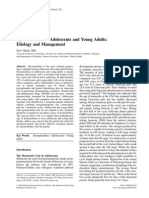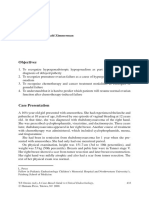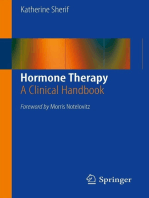The Pathophysiology of Amenorrhea
The Pathophysiology of Amenorrhea
Uploaded by
Tri Suci UtamiCopyright:
Available Formats
The Pathophysiology of Amenorrhea
The Pathophysiology of Amenorrhea
Uploaded by
Tri Suci UtamiCopyright
Available Formats
Share this document
Did you find this document useful?
Is this content inappropriate?
Copyright:
Available Formats
The Pathophysiology of Amenorrhea
The Pathophysiology of Amenorrhea
Uploaded by
Tri Suci UtamiCopyright:
Available Formats
The Pathophysiology of Amenorrhea in the Adolescent N EVILLE H. G OLDEN AND J ENNIFER L.
C ARLSON Division of Adolescent Medicine, Stanford University School of Medicine, Mountain View, California, USA Menstrual irregularity is a common occurrence during adolescence, especially within the first 23 years after menarche. Prolonged amenorrhea, however, is not normal and can be associated with significant medical morbidity, which differs depending on whether the adolescent is
estrogen-deficient or estrogen-replete. Estrogen-deficient amenorrhea is associated with reduced bone mineral density and increased fracture risk, while estrogen-replete amenorrhea can lead to dysfunctional uterine bleeding in the short term and predispose to endometrial carcinoma in the long term. In both situations, appropriate intervention can reduce morbidity. Old paradigms of whom to evaluate for amenorrhea have been challenged by recent research that provides a better understanding of the normal menstrual cycle and its variability. Hypothalamic amenorrhea is the most prevalent cause of amenorrhea in the adolescent age group, followed by polycystic ovary syndrome. In anorexia nervosa, exercise-induced amenorrhea, and amenorrhea associated with chronic illness, an energy deficit results in suppression of hypothalamic secretion of GnRH, mediated in part by leptin. Administration of recombinant leptin to women with hypothalamic amenorrhea has been shown to restore LH pulsatility and ovulatory menstrual cycles. The use of recombinant leptin may improve our understanding of the pathophysiology of hypothalamic amenorrhea in adolescents and may also have therapeutic possibilities. Key words: amenorrhea; adolescents Menstrual irregularity is a common occurrence during adolescence,especially within the first 2 to 3years after menarche. Prolonged amenorrhea, however, is not normal and can be associated with significant medical morbidity, which differs depending on whether the adolescent is estrogen-deficient or estrogen-replete. In both situations, appropriate intervention can reduce morbidity. Old paradigms of whom to evaluate for amenorrhea have been challenged by recent research that provides a better understanding of the normal menstrual cycle and its variability. The aim of this chapter is to review the pathophysiology of amenorrhea in adolescents and to serve as an overview for the more detailed discussions of specific etiologic conditions in the chapters to follow. Priorities for future research will be proposed on the basis of review of the
recent literature. Address for correspondence: Neville H. Golden, M.D., Chief, Division of Adolescent Medicine, Stanford University School of Medicine, 1174 Castro Street, Suite 250 A, Mountain View, CA 94040. Voice: 650-6940660; fax: 650-694-0664. ngolden@stanford.edu The Normal Menstrual Cycle Menarche In the United States and Europe, the median age of menarche declined from 16 to 17years in the mid-1800s to approximately 12.5years in the mid1900s, presumably because of better nutrition and improved socioeconomic living conditions. Over the past 30years, however, the median age of menarche in the United States has remained relatively stable. Age of menarche varies in different countries and tends to be higher in less-developed countries and lower in welldeveloped countries. Using a national probability sample of 2,510 girls aged 8.0 to 20.0years, Chumlea et al. found that the median age of menarche in the United States is 12.43years and 80% of all girls begin to menstruate between 11.0 and 13.75years. Fewer than 10% are menstruating by age 11 and 90% are doing so by age of 13.75years. 1 By the age of 15years, 98% of all girls have reached menarche. 2 Both pubertal development and age at menarche vary by race, with black
girls entering puberty earlier than their white counterparts and reaching menarche before them. 3 In the United States, mean age of menarche is 12.06years in blacks, 12.25years of age in Mexican Americans, Ann. N.Y. Acad. Sci. 1135: 163178 (2008). C 2008 New York Academy of Sciences. doi: 10.1196/annals.1429.014 163 164 Annals of the New York Academy of Sciences FIGURE 1. Regulation of pulsatile GnRH secretion by leptin and neurotransmitters. and 12.55years of age in non-Hispanic whites. 1 There is a known relationship between age of menarche and BMI, with early menarche associated with higher BMI. 4 , 5 What is not known, however, is the direction of the associationwhether increased body fat leads to early menarche or whether early sexual maturation is the reason for an increase in the amount of body fat and a change in its distribution. Physiology of the Normal Menstrual Cycle
An understanding of the physiology of the normal menstrual cycle (see the chapter by Dr. Hillard in this volume) is essential in order to understand the variability of menstrual cycles that occurs during adolescence. Gonadotropin-releasing hormone (GnRH), a decapeptide produced by the neurosecretory neurons of the preoptic area of the hypothalamus, is released at the axon terminals of the neurosecretory cell at the median eminence of the hypothalamus. The hormone is secreted into the capillaries of the hypophysial portal system and is transported to the anterior pituitary, where it stimulates the synthesis and secretion of luteinizing hormone (LH) and follicle-stimulating hormone (FSH). The GnRH is released in pulses in response to serum levels of gonadal steroids. Secretion of GnRH is also regulated by a number of neurotransmitters, including dopamine, endogenous opioids, norepinephrine, gamma amino butyric acid (GABA),andcorticotropin-releasinghormone(CRH). Some of these neurotransmitters (e.g., dopamine) are released by the tuberoinfundibular neurons which abut the neurosecretory cells of the median eminence. 6 The modulation of GnRH release by the neurotransmitters is complex. with interactions between the different regulatory systems (F IG .1). For example, infusion of dopamine inhibits the LH pulsatile release induced by naloxone, an opioid receptor antagonist. 7
Other neurotransmitters (e.g., serotonin, neuropeptide Y, and neurotensin) may be involved in the regulation of GnRH secretion, but their exact role is not clear. The GnRH pulses increase in amplitude and frequency during puberty. Each GnRH pulse is followed
You might also like
- Michael W, COMAT ObgynDocument12 pagesMichael W, COMAT ObgynSeanNo ratings yet
- This Study Resource Was: ATI Maternal Newborn Proctored Exam Study Set 1Document4 pagesThis Study Resource Was: ATI Maternal Newborn Proctored Exam Study Set 1Gina Giammalvo100% (5)
- Breast Examination - ADocument30 pagesBreast Examination - AAkash Verma100% (1)
- Case Study (Aub)Document16 pagesCase Study (Aub)Lucila Lugo0% (2)
- Sample Memo AgreementDocument4 pagesSample Memo AgreementCandypopNo ratings yet
- Mini-Review: Dysmenorrhea in Adolescents and Young Adults: Etiology and ManagementDocument9 pagesMini-Review: Dysmenorrhea in Adolescents and Young Adults: Etiology and ManagementyedahNo ratings yet
- Dysmenorrhea in AdolescentsDocument12 pagesDysmenorrhea in AdolescentsDeff HaningNo ratings yet
- Puberty. Menopause. Women's Ageing: Manuela RussuDocument41 pagesPuberty. Menopause. Women's Ageing: Manuela RussuAnonymous 0XqZUl06PmNo ratings yet
- NIH Public Access: Author ManuscriptDocument16 pagesNIH Public Access: Author ManuscriptnurrahmaNo ratings yet
- Menopouse 26 45 PDFDocument21 pagesMenopouse 26 45 PDFevilasusantiNo ratings yet
- Adolescent Gynecologic Care QUESTIONS 1, 2, 3Document7 pagesAdolescent Gynecologic Care QUESTIONS 1, 2, 3patelkn_2005No ratings yet
- CastelloDocument6 pagesCastellosaifulmangopo123No ratings yet
- Diagnosis and Management of Premature Ovarian InsufficiencyDocument16 pagesDiagnosis and Management of Premature Ovarian InsufficiencydcomandeNo ratings yet
- MenopauseDocument15 pagesMenopausesharmaatul13No ratings yet
- 3 - Precocious PubertyDocument9 pages3 - Precocious PubertyJohnM.GiraldoNo ratings yet
- KaleidoscopeDocument2 pagesKaleidoscopeKasep PisanNo ratings yet
- Adolescent AnovulationMaturational MechanismsDocument12 pagesAdolescent AnovulationMaturational MechanismsFrancis RomanosNo ratings yet
- The Postmenopausal Women - Endotext - NCBI BookshelfDocument43 pagesThe Postmenopausal Women - Endotext - NCBI Bookshelfraiza frotaNo ratings yet
- Thetreatmentof Dysmenorrhea: Sheryl A. RyanDocument12 pagesThetreatmentof Dysmenorrhea: Sheryl A. Ryanfhie_amandaNo ratings yet
- Premature Ovarian Insufficiency: An International Menopause Society White PaperDocument22 pagesPremature Ovarian Insufficiency: An International Menopause Society White PaperdcomandeNo ratings yet
- Es5Document13 pagesEs5yue ruanNo ratings yet
- Alzheimers Disease Menopause - Estrogenic EnvironmentDocument4 pagesAlzheimers Disease Menopause - Estrogenic EnvironmentsnarathanNo ratings yet
- Treatment and Outcomes of Precocious Puberty: An UpdateDocument11 pagesTreatment and Outcomes of Precocious Puberty: An UpdateAbdurrahman Hasanuddin100% (1)
- Menopause: Hormones, Lifestyle, and Optimizing AgingDocument15 pagesMenopause: Hormones, Lifestyle, and Optimizing Agingsetya rini100% (1)
- Amenorrea Imprimir PDFDocument9 pagesAmenorrea Imprimir PDFKelly F RuizNo ratings yet
- Selección de Resúmenes de Menopausia Semana Del 5 Al 11 de Noviembre de 2014Document3 pagesSelección de Resúmenes de Menopausia Semana Del 5 Al 11 de Noviembre de 2014rocksurNo ratings yet
- Academic Audience Final DraftDocument18 pagesAcademic Audience Final Draftapi-708250948No ratings yet
- Pesce-Zimmerman2008 Chapter AmenorrheaDocument4 pagesPesce-Zimmerman2008 Chapter Amenorrheaالبكالوريوس المكثف فى التمريضNo ratings yet
- Menstrual Disorders in Adolescents: The Internet Journal of Gynecology and ObstetricsDocument34 pagesMenstrual Disorders in Adolescents: The Internet Journal of Gynecology and ObstetricsNayla Adira04No ratings yet
- Reproductive EndocrinologyDocument197 pagesReproductive EndocrinologyWael GaberNo ratings yet
- Anti-Mu Llerian Hormone Concentrations in Maternal Serum During PregnancyDocument4 pagesAnti-Mu Llerian Hormone Concentrations in Maternal Serum During PregnancyHugo Mendez de LeiteNo ratings yet
- Cme Reviewarticle: What The Obstetrician/Gynecologist Should Know About Thyroid DisordersDocument7 pagesCme Reviewarticle: What The Obstetrician/Gynecologist Should Know About Thyroid DisordersEdgar PazNo ratings yet
- First Page PDFDocument1 pageFirst Page PDFAmenNo ratings yet
- jjjjjpn-40-219Document3 pagesjjjjjpn-40-219yue ruanNo ratings yet
- 4851-Article Text-14655-2-10-20170116 PDFDocument14 pages4851-Article Text-14655-2-10-20170116 PDFKIMNo ratings yet
- Menopause - StatPearls - NCBI BookshelfDocument8 pagesMenopause - StatPearls - NCBI BookshelfMichael HusainNo ratings yet
- W2-11 Neurological Issues in Women - LectureDocument47 pagesW2-11 Neurological Issues in Women - LectureNanjit SharmaNo ratings yet
- Endo Part IVDocument40 pagesEndo Part IVChippy RabeNo ratings yet
- Ray Peat - Letter To The Editor - Oral Absorption of ProgesteroneDocument2 pagesRay Peat - Letter To The Editor - Oral Absorption of ProgesteroneMihai DragomirNo ratings yet
- Menopause Perimenopause: By: Rem Alfelor Page 1 of 3Document3 pagesMenopause Perimenopause: By: Rem Alfelor Page 1 of 3Remelou Garchitorena AlfelorNo ratings yet
- Approach To The Patient With New-Onset Secondary Amenorrhea: Is This Primary Ovarian Insufficiency?Document11 pagesApproach To The Patient With New-Onset Secondary Amenorrhea: Is This Primary Ovarian Insufficiency?Patricia Rearte CarvalhoNo ratings yet
- MenopauseDocument14 pagesMenopauseMizna SabillaNo ratings yet
- Endocrinology - EncyclopediaDocument2,399 pagesEndocrinology - Encyclopediaviobanaruu0% (1)
- Normal and Abnormal PubertyDocument37 pagesNormal and Abnormal Pubertyhazab1968100% (1)
- Labial AdhesionsDocument2 pagesLabial AdhesionsLydia TsiapleNo ratings yet
- Menopause Related Sleep Disorders PDFDocument10 pagesMenopause Related Sleep Disorders PDFason10No ratings yet
- In This Issue: Mitochondrial Disease and Dysautonomia: Exploring The LiteratureDocument17 pagesIn This Issue: Mitochondrial Disease and Dysautonomia: Exploring The LiteraturedoctornulNo ratings yet
- MenstrualDisorders - PIR .2013 PDFDocument15 pagesMenstrualDisorders - PIR .2013 PDFlina robayoNo ratings yet
- Case Study: Post-Infectious Hydrocephalus and Indirect Inguinal HerniaDocument24 pagesCase Study: Post-Infectious Hydrocephalus and Indirect Inguinal HerniaArha Mae BaliwasNo ratings yet
- Epilepsy in WomenDocument6 pagesEpilepsy in WomenKurniawan FatoniNo ratings yet
- Precocious PubertyDocument11 pagesPrecocious PubertyRo RojasNo ratings yet
- Complementary and Alternative Medical Lab Testing Part 9: GynecologyFrom EverandComplementary and Alternative Medical Lab Testing Part 9: GynecologyNo ratings yet
- Anxiety Attacks Following Surgical Menopause: Clinical Case ReportDocument5 pagesAnxiety Attacks Following Surgical Menopause: Clinical Case ReportEstrebello EstinoNo ratings yet
- Hunter 2007Document14 pagesHunter 2007SDani03No ratings yet
- 2003 GM 115 ThibaudDocument15 pages2003 GM 115 ThibaudJosuéNo ratings yet
- Amenorrhea & Heavy Menstrual BleedingDocument22 pagesAmenorrhea & Heavy Menstrual BleedingJanesel Plariza PanerioNo ratings yet
- Precocious PubertyDocument80 pagesPrecocious Pubertysergio salazarNo ratings yet
- Precocious Puberty 10.03.2011Document17 pagesPrecocious Puberty 10.03.2011Emily Eresuma100% (1)
- Notes Infertility Delayed PubertyDocument9 pagesNotes Infertility Delayed PubertyTONY GO AWAYNo ratings yet
- Congenital Hyperinsulinism: A Practical Guide to Diagnosis and ManagementFrom EverandCongenital Hyperinsulinism: A Practical Guide to Diagnosis and ManagementDiva D. De León-CrutchlowNo ratings yet
- A Comprehensive Exploration of Amenorrhea and Women's HealthFrom EverandA Comprehensive Exploration of Amenorrhea and Women's HealthNo ratings yet
- Gender Medicine: The Groundbreaking New Science of Gender- and Sex-Related Diagnosis and TreatmentFrom EverandGender Medicine: The Groundbreaking New Science of Gender- and Sex-Related Diagnosis and TreatmentNo ratings yet
- Endocrine Equilibrium: Navigating the Hormonal Seas: Navigating the Whispers of Hormones: A Delicate Dance of BalanceFrom EverandEndocrine Equilibrium: Navigating the Hormonal Seas: Navigating the Whispers of Hormones: A Delicate Dance of BalanceNo ratings yet
- Menstrual Hygiene ManagementDocument3 pagesMenstrual Hygiene ManagementRonnel PostanesNo ratings yet
- Menstural Cycle DISORDERSDocument28 pagesMenstural Cycle DISORDERSnawaz akhtarNo ratings yet
- What Does Two Placentas With Twins Mean 2 Fathers - Google SearchDocument1 pageWhat Does Two Placentas With Twins Mean 2 Fathers - Google SearchZion OlmosNo ratings yet
- Curriculum VitaeDocument12 pagesCurriculum VitaeAnonymous 3FCoQaTukNo ratings yet
- Review Article: Oketani Lactation Management: A New Method To Augment Breast MilkDocument5 pagesReview Article: Oketani Lactation Management: A New Method To Augment Breast MilkrisaNo ratings yet
- Role of MicronizedDocument40 pagesRole of MicronizedAkhilesh KumarNo ratings yet
- Female Reproductive SystemDocument42 pagesFemale Reproductive SystemMaulidyaAlistaNo ratings yet
- Mal PresentationDocument5 pagesMal Presentationhomework8589No ratings yet
- Skenario A Blok 17 L3 FixDocument35 pagesSkenario A Blok 17 L3 FixSelli Novita BelindaNo ratings yet
- Malposition & MalpresentationDocument36 pagesMalposition & MalpresentationN. Siva50% (2)
- ADIL BSN - 1C 11. Manual Reproductive SystemDocument4 pagesADIL BSN - 1C 11. Manual Reproductive SystemReiko SakaeNo ratings yet
- Maternity Center FsDocument54 pagesMaternity Center FsJay ArNo ratings yet
- Mammo MidtermsDocument23 pagesMammo MidtermsCherie lou PizaNo ratings yet
- Gestational Trophoblastic Disease (GTD) : Ahmed Refaat Abd ElzaherDocument41 pagesGestational Trophoblastic Disease (GTD) : Ahmed Refaat Abd ElzaherJessica NadiaNo ratings yet
- Jurnal KBDocument7 pagesJurnal KBAnahNo ratings yet
- 04 New Obstetric ExaminationDocument44 pages04 New Obstetric Examinationfranny90No ratings yet
- Berita Acara Minggu Ke 1Document5 pagesBerita Acara Minggu Ke 1Hidaya UlyaaNo ratings yet
- Uterine InversionDocument15 pagesUterine InversionMaggie Huatea Schnittka50% (2)
- Joshi Abhishek F.Y.P.B.B.SC - Nursing Govt College of Nursing JamnagarDocument49 pagesJoshi Abhishek F.Y.P.B.B.SC - Nursing Govt College of Nursing JamnagarPoonam RanaNo ratings yet
- Pasar P1 Exam Japun CutieDocument16 pagesPasar P1 Exam Japun CutieLeevine DelimaNo ratings yet
- National Action Plan On Breastfeeding 2022 - 2027Document49 pagesNational Action Plan On Breastfeeding 2022 - 2027manjisthaNo ratings yet
- Telephone Triage Tool For NeonatesDocument1 pageTelephone Triage Tool For Neonatesrevi rillianiNo ratings yet
- Intrapartum NCM 107Document8 pagesIntrapartum NCM 107Kimberly Sharah Mae Fortuno100% (1)
- Group C - MiniOSCEDocument11 pagesGroup C - MiniOSCEMohammad AlrefaiNo ratings yet
- GDM With PolyhydramniosDocument4 pagesGDM With PolyhydramniosSure NavyasriNo ratings yet
- Shoulder Dystocia: District 1 ACOG Medical Student Education Module 2011Document17 pagesShoulder Dystocia: District 1 ACOG Medical Student Education Module 2011normaNo ratings yet

























































































